In 'Squid Game' Season 3, New Arenas Toy With Life and Death More Than Ever
Production designer Chae Kyoung-sun breaks down her inspirations and Easter eggs from the global hit’s final installment.


This interview includes major spoilers for Squid Game season 3. Since its initial debut in September 2021, Squid Game has become more than a series—it’s a full-blown aesthetic. Now, you'd be hard-pressed not to look at a teal-green tracksuit without thinking of the devastating death-game K-drama, which imbues traditional Korean children’s games with bleak social commentary on inequality, desperation, and depravity.
Its colorful, labyrinthine set is also part of its signature, helmed by production designer Chae Kyoung-sun. Throughout the three-season run of Netflix’s most-viewed series ever, she collaborated with writer-director Hwang Dong-hyuk on the dystopian nightmare, taking home an Emmy and two Art Directors Guild Awards for her work on the show’s sensational game arenas and stylized facilities. To create an imposing conclusion in the third and final season, Chae reflected on the narrative motifs that have threaded through the entire series, culminating in the inevitable end of deadbeat-turned-victor Gi-hun’s (Lee Jung-jae) journey.
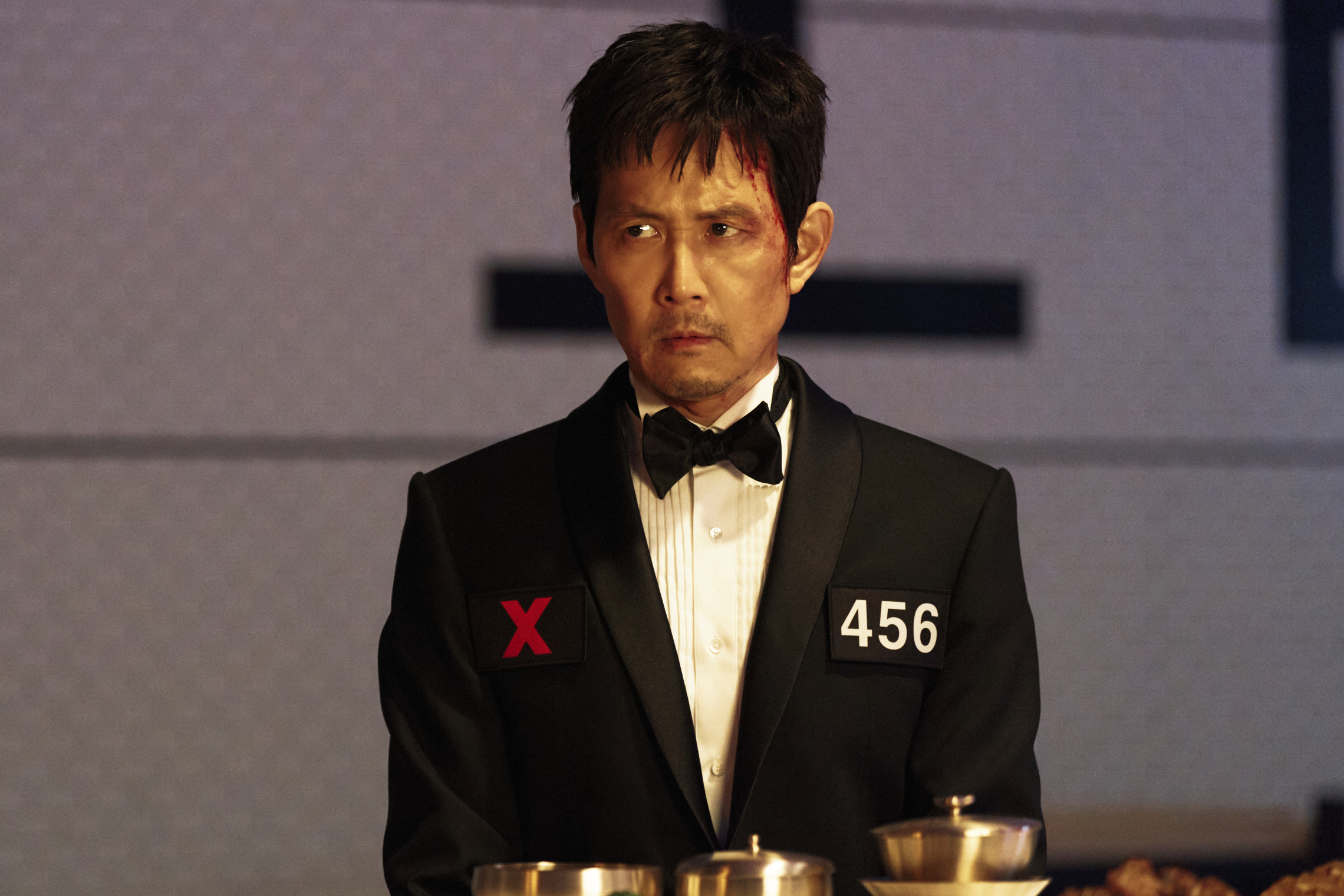
Gi-hun (Lee Jung-jae) at the finalist's dinner.
“I’ve never set out to inspire anyone in particular,” Chae tells Marie Claire over email, when asked about the global legacy of her work on Squid Game. “Rather than aiming to create iconic visuals, my hope was to enrich the story through art direction and faithfully reflect the themes of Squid Game.”
Still, no matter how humble the art director is, Squid Game’s visual trademarks—from the skyscraper-sized doll Young-hee to black geometric masks to unending staircases in Pepto-Bismol pink—will live on beyond the final episodes, which arrive on the streaming giant on June 27.
Below, Chae chats with Marie Claire (via a translator) about the hidden Easter eggs in season 3’s new games, the cyclical themes throughout her design choices, and why production design requires becoming a chameleon.
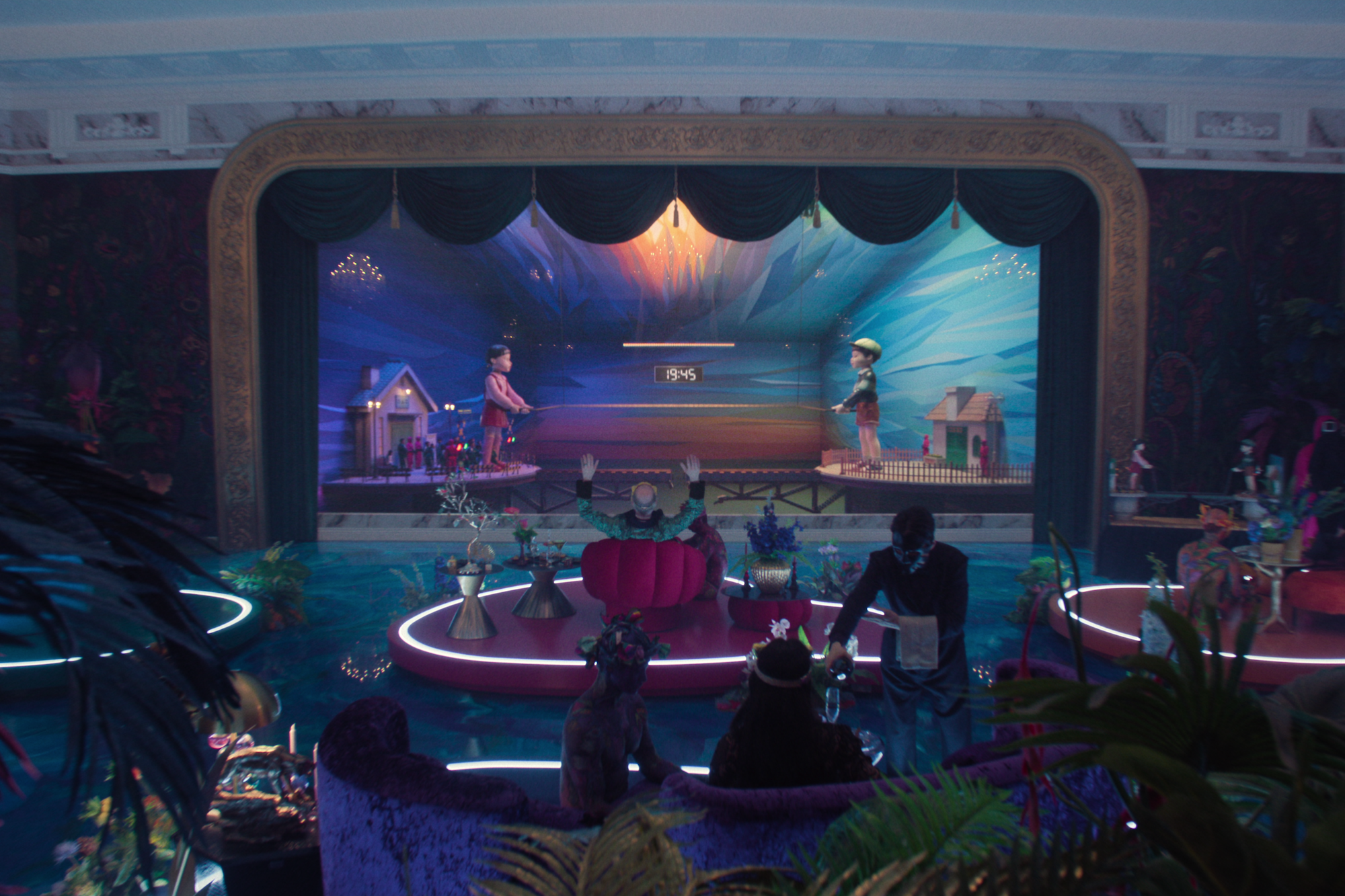
The VIPs watch Jump Rope.
MC: Season 3 returns to facility areas we’ve seen previously, like the VIP area. When designing the new season, did you try to make the room dimensions similar to season 1?
Chae Kyoung-sun: Squid Game has a consistent context and theme that runs through its universe, so I worked off of the material that I referenced for season 1. For the VIP room, we debated whether we should recreate the room exactly as it was in season 1 because Jun-ho (Wi Ha-jun) would be in it again, and the space needed to seem familiar. However, we didn’t want it to be identical because it would be no fun that way. After considering various options, we decided to keep the same structure, so the stairs, the room size, and the general set-up remain the same. But Director Hwang wanted to tweak the background, large props, and other design elements, so whereas we mostly used black marble in season 1, we chose white for season 3. The thinking behind choosing white marble was that I wanted it to feel like the ocean. I wanted the floor, where the VIPs are sitting, to remind people of the sea, because this entire place is on an island—a secluded, closed-off space, almost like a league of their own.
Get exclusive access to fashion and beauty trends, hot-off-the-press celebrity news, and more.
MC: The Hide and Seek arena has similar bricks and stairs to the Marbles neighborhood in season 1, and both games include some emotionally devastating deaths. Were you aiming for viewers to be reminded of Marbles when you designed the Hide and Seek arena?
CK: Overall, the game sets were designed to maintain cohesiveness with the universe of season 1. Rather than creating something completely new, I wanted to deepen and vary the themes and philosophical undertones that Squid Game represents. While it wasn’t intentional to make it resemble the Marbles game arena, the space evolved in that direction, as it had to hold scenes of heartbreaking deaths and characters in emotional turmoil. To amplify that emotional trajectory, the space was shaped accordingly.
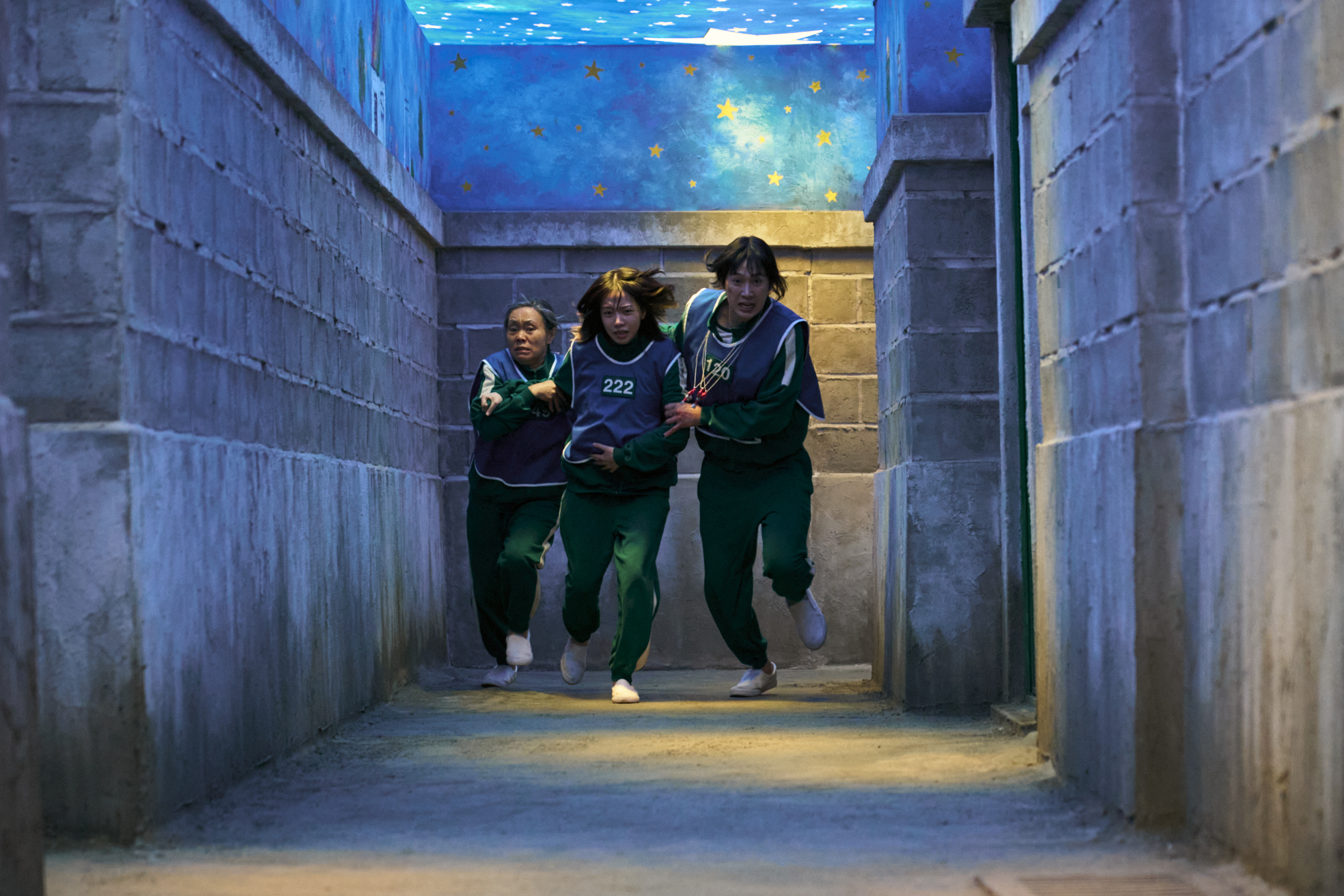
Geum-ja (Kang Ae-sim), Jun-hee (Jo Yu-ri), and Hyun-ju (Park Sung-hoon) form a team during Hide and Seek.
A star-filled night sky may be beautiful, but there’s no room here to hide. This is a space where participants must frantically search for an exit to escape death—stripped of humanity, they wander through a seemingly inescapable maze where brutal stabbings unfold. The Hide and Seek arena is where warm starlight and streetlamp glows contrast with pools of blood from the players. If the alleyways in season 1 served as narrative background, the alleyways in season 3 flow with the participants. Wandering through endless alleys, they open doors to find rooms that look as if they were decorated by children. Walls filled with paper, scribbles, and colorful paint evoke innocence and dreams, which spark eerie emotions instead of nostalgia in the terror-stricken participants. The scratch room, covered in vibrant colors, serves as a grotesque contrast to the massacre it hosts, making the violence seem all the more detached from morality.
In this game, where killing is trivialized as entertainment, rooms show free skies, birds, and trees; and the room where a baby is born is designed to express the depths of the sea to symbolize amniotic fluid and the birth of life. In the room where killing takes place in a family, imagery of dreams and hope—rainbows and white butterflies—is paradoxically included. There’s a Korean superstition that if a white butterfly enters your home in spring, a family member will die. In the final room leading to the exit, red handprints are stamped on the door to visually capture the reality that many participants ultimately meet their death here despite their desperate attempts to grasp the handle and hold on.
Marie Claire: Of the three new games—Hide and Seek, Jump Rope, and Sky Squid Game—which was the most challenging to design?
Chae Kyoung-sun: Sky Squid Game was the set that gave us a headache until the very end. The simpler the game is, the harder it is to design the set. In season 1’s final game, we just had a simple circle, triangle, and square drawn on the floor, but for season 3, Director Hwang [Dong-hyuk] envisioned the game taking place mid-air. So at first, I was a bit lost, but then we decided the keyword for this last game would be ‘fall.’ We really wanted to build a set that would emphasize the impact of Gi-hun’s last scene. To me, it seemed like Director Hwang’s most important message was conveyed in those moments.
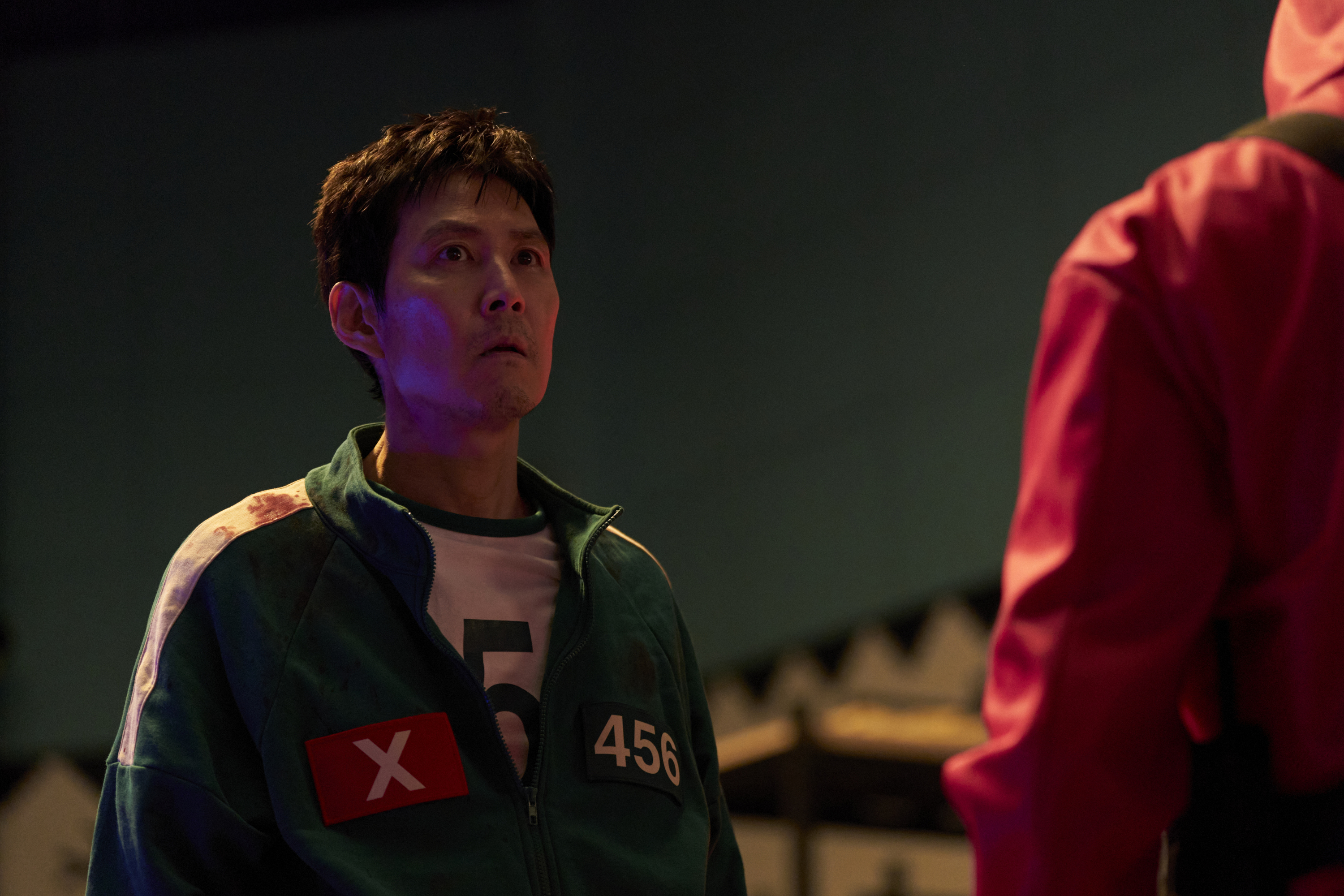
Gi-hun (Lee Jung-jae) faces a guard.
MC: What artistic or architectural inspirations did you draw from to bring the giant pillars in Sky Squid Game to life?
CK: A key inspiration that runs through the entire production design of Squid Game is the Möbius strip. The maze-like staircase, the Hide-and-Seek game, and everything in general reflect how everything comes full circle and repeats infinitely, much like the cycle of life and death. As for the pillars, the structure in the shape of circle, triangle, and square represent the components of Squid Game. I included the staircases inside the structure to imply that we are trapped inside these shapes. The Möbius stairs are so narrow that it’s impossible to walk on them, and there’s no entrance or exit. Additionally, as the players are going up in an elevator, you can see the Möbius strip motif there as well. Director Hwang mentioned keywords like ‘crack,’ ‘crevice,’ ‘chasm,’ and ‘poor construction work,’ and he wanted to include these elements in the set for the final game. So, we drew inspiration from the imagery of these cracks widening, the structures crumbling and collapsing, like we see in the social system, and expressed that in this set.
MC: The show’s lighting has become more stylized throughout its run. What was the thought process there?
CK: Gi-hun’s character changes noticeably between seasons 1 and 2. He develops an unwavering desire to stop the game and overturn the system, gaining both inner darkness and a strong sense of purpose. These aspects of his growth and emotional shift were reflected through lighting contrasts and color choices that shaped the overall visual style. The opposing O and X lights in the pivotal voting scene symbolized that contrast, and the lighting in seasons 2 and 3 became more diverse and multidimensional as a result.
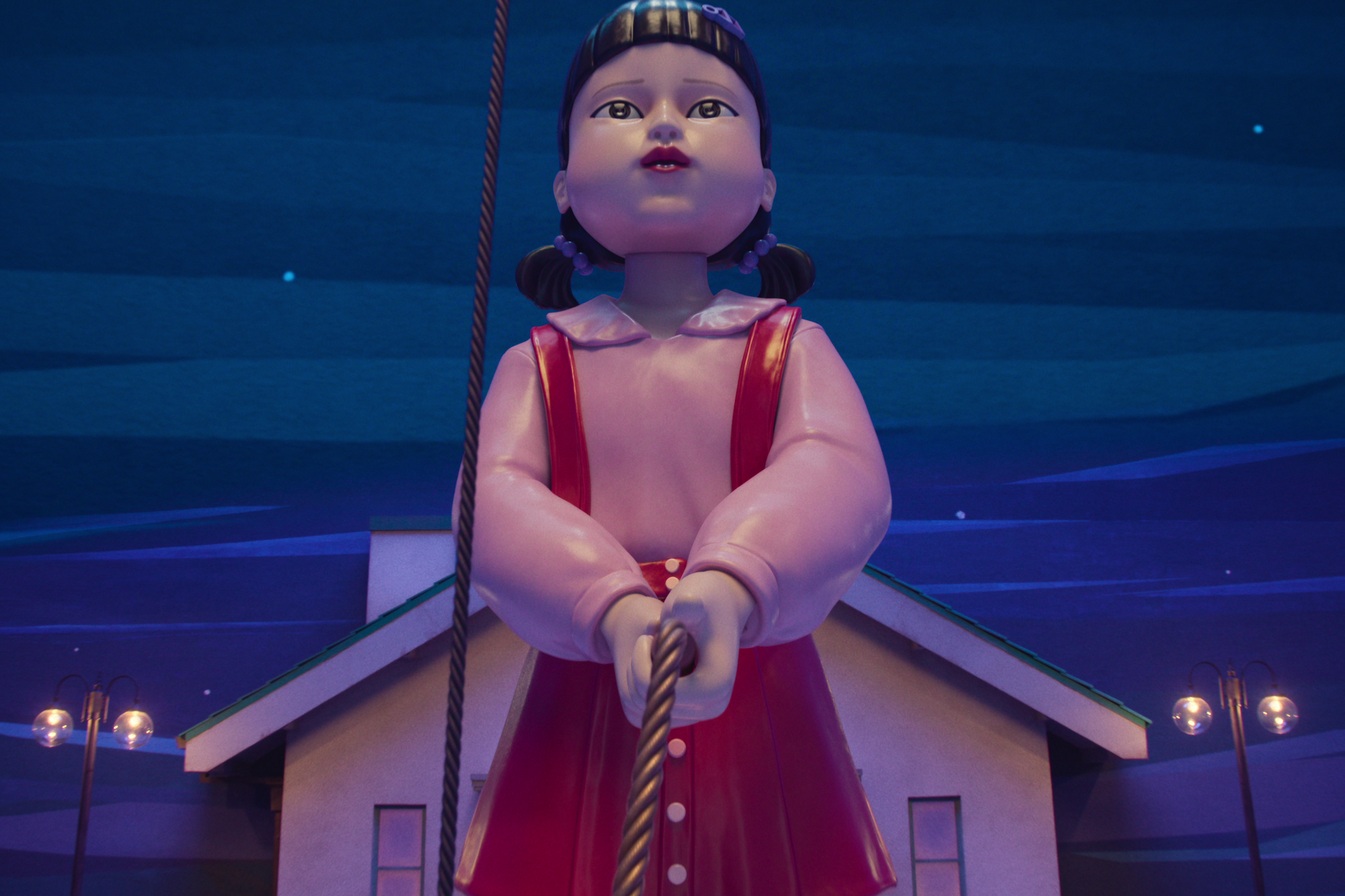
Young-hee returns for Jump Rope.
MC: In season 1, fans noticed that once the bunks were removed from the main dormitory, the wall art served as hints for the games in each round. Is there also a secret message on the walls in season 3?
CK: For the dormitory of seasons 2 and 3, a Latin saying, ‘Hodie mihi, cras tibi,’ is written across the walls. It means, ‘It is I today, you tomorrow.’ Director Hwang told me that it is interpreted into, ‘I’m the one inside the coffin today, and it will be you tomorrow,’ meaning that death doesn’t belong to only me and that you always have to be thinking about death. So I got to thinking a lot about graveyards and what’s written on tombstones. We spent a lot of time designing the font, too, whether we should use the font that’s more antique, or use emoji-like icons and simplify the text.
The image of people hanging on the walls [across the top of the dormitory walls] was designed to reflect the players' psychological state, how they’ve been pushed to this extreme state, excluded from the real world.
Another design I put my most effort into is the wall image of a checkerboard of crosses that resembles a graveyard. It’s symmetrical horizontally and divided into top and bottom. With this design, I wanted to portray ‘life facing death,’ the constant insecurity and anxious mental state of the players, and the way they face death.
MC: Squid Game’s visuals have become iconic. With the series ending, how do you hope the legacy of its design will inspire future productions or artists?
CK: I’ve never set out to inspire anyone in particular. Joining the Squid Game project was a great opportunity—one that allowed me to take on new visual challenges and explore creative expression. I’m now working on new projects that are completely different in genre and visual language from Squid Game. Depending on the story I’m given, I find myself transforming almost like a chameleon. In many ways, I think being a production designer is a lot like being a chameleon. I look forward to meeting audiences again soon, immersed in a new world of color and spatial design through different projects.
This interview has been edited and condensed for clarity.

Quinci LeGardye is a Culture Writer at Marie Claire. She currently lives in her hometown of Los Angeles after periods living in NYC and Albuquerque, where she earned a Bachelor’s degree in English and Psychology from The University of New Mexico. In 2021, she joined Marie Claire as a contributor, becoming a full-time writer for the brand in 2024. She contributes day-to-day-content covering television, movies, books, and pop culture in general. She has also written features, profiles, recaps, personal essays, and cultural criticism for outlets including Harper’s Bazaar, Elle, HuffPost, Teen Vogue, Vulture, The A.V. Club, Catapult, and others. When she isn't writing or checking Twitter way too often, you can find her watching the latest K-drama, or giving a concert performance in her car.